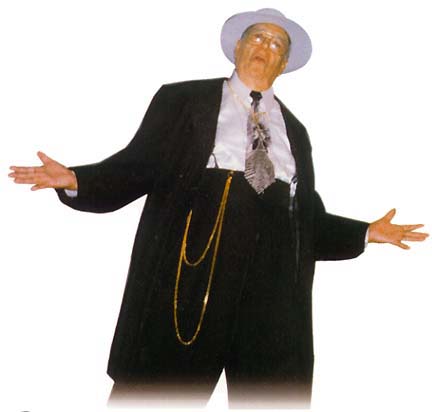
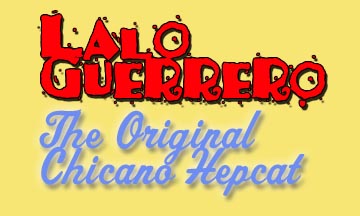
by Skip Heller
( Exclusive to Dana
Countryman.com)
Mexican music legend Lalo
Guerrero passed away on March 17th, 2005, at the age of 88. The
trendsetting troubadour started a musical revolution in Latino
music that is still being felt today.
Skip Heller's article was
written in 2000, when Lalo was alive and still busy making
music.
It's July 17, a sun-drenched LA afternoon.
Just a stone's throw from the Police Academy is an annual picnic
to commemorate the mass dispossession of Mexican-Americans who
lived in Chavez Ravine until the area was cleared for Dodger Stadium.
The attendees fall into two groups those who were put out of their
homes, and their descendants. Sitting on a small bandstand, singing
in Spanish and strumming an acoustic guitar, is an old but still
charismatic Chicano man. The crowd receives him with wild applause.
They pay little attention to the skinny gringo next to him, who
is also playing the guitar, except to cheer after the guitar solos.
Afterward, the old man sits at a table beneath a shady tree, selling
CDs of his music. Members of the crowd walk up to him alone, or
with a family member. Unfailingly, each relates a story to him
about the impact his music has made on their lives. Everyone wants
an autograph.
"Lalo, my grandfather used to play me your records."
"Lalo, my wife and I met at one of your shows, fifty years
ago." "Lalo, can you make it out to . . ."
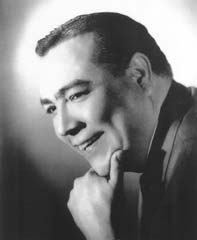
He listens and obliges each with a warm smile. These are his people,
and, like a benevolent monarch, he listens attentively to each.
the is no posturing nor pretense about him.
Lalo Guerrero, 82, is the father of Chicano music. Though he started
out recording typical mexican music in the late thirties, he soon
became the first to join Mexican-Spanish lyrics and slang to American
styles (swing, R&B), and his bilingual jump blues, such as
"Marihuana Boogie" and "Vamos a Bailar," are
classics, and were practically anthems to late-1940s pachucos.
"I used to play at a club at Spring and Macy that was very
popular with the movie crowd. Rita Hayworth and John Garfield
would come down there," he recalls. "And the other
thing we got was a lot of zoot suiters. They were really sharp-dressed
and clean not like the gangs of today. They loved swing, so we
played it, and also the conga, the rhumba and boleros the sad
love songs in Spanish.
"I recorded with a trio on Imperial Records, and I said,
`Why don't we write some swing songs in Spanish for these people?
Not only in Spanish, but in their kind of slang Spanglish'. They
loved it."
Guerrero's music jumped hard enough to reach past its intended
audience. I once dated an African-American woman who had inherited
her Uncle Adolph's collection of 78s. The uncle had worked on
Central Avenue in the forties, which was Black L.A.'s entertainment
hub. Adolph had a tidy little cache of Lalo 78s among his Roy
Milton's and Louis Jordan's. According to L.A. rhythm'n'blues
scholar/historian Jim Dawson, Lalo Guerrero was quite popular
with LA's African-American comminuty. I asked Lalo if the band
was racially mixed. His many 78s (cut for Imperial) during that
time range from typical mariachi to credible boogie woogie and
jump blues. The group was not, in fact, racially mixed. Impressively,
he used the same musicians on his sessions no matter what style
of music he brought to record. Their command of Latin, African-American,
and even white pop styles was unanimously credible.
"The band was all Latin, but our audience was 60 percent
blacks and whites. We did swing and boogie-woogie, but we also
did Latin, tropical. We mixed it up, and that's why people liked
it. At that time, L.A. was a very peaceful town. There wasn't
really trouble between the races."
Fittingly, Guerrero's jump tunes were featured throughout the
1984 musical Zoot Suit, which was both a stage play and a film
starring Edward James Olmos. He has a snazzy new CD on Break-Records:
Vamos a Baile Otra Vez (Get Out and Dance Once More)
that focuses on both swing and Latin big-band styles. The Smithsonian
recently acknowledged Guerrero as a "national folk treasure,"
and President Clinton awarded him the National Medal of the Arts.
When asked if he was thrilled about getting medal, he shrugs.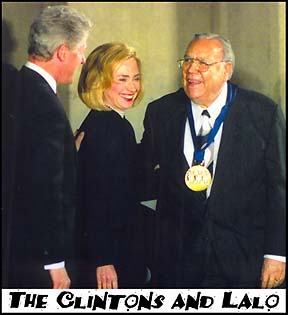
"I guess so. They were giving one to Lionel Hampton the
same night, and I was more excited about meeting Lionel Hampton
and spending time with him."
(Sherilyn Meece Mentes told me that, one afternoon while she was
helping Lalo organize his papers, she found a sheaf of letters
of commendation. The certificate that accompanied Lalo's Medal
of Arts was in a stack along with certifcates from the Cathedral
City Ladted at the White House but doesn't really care that much
about it. He is regal, at ease and expansive. What purports to
be an interview turns into Lalo holding court. The warning signs
were there. When I told Nadine Trujillo, owner/self-described
Taco Nazi of the famed "hangout of the stars" Mexican
restaurant Alegria On Sunset, she insisted on making a traditional
Mexican breakfast with all the trimmings and asked if she could
have her picture taken with Lalo. Lalo told me he was going to
have a couple of friends meet him there, if that was okay. I said
fine, and an entourage showed up. His biographer, Sherilyn Meece
Mentes, Ben Esparza (the president of Break Records) and his wife,
and a couple of others.
I brought my pal Carmen Hillebrew, a lovely
woman with whom Lalo flirted throughout the meal. He also flirted
with any other woman in arm's reach, including Nadine. But, since
Carmen was at the table, she got the most attention. Although
happily married for many years, Lalo likes the ladies. I think
as much, Lalo just likes to play the part of the old wolf. Trying
to keep him focused enough to answer a question is hell. He is
attentive to everybody at once, which is not the greatest thing
in the world for what purports to be an in-depth interview. Eventually,
I just leave the tape recorder running. It's clear that he'll
tell the stories he wants to tell, clarify the points he wants
made clear, and pay attention to any female who gets within five
feet of him. He talks about how the young gangs of today trouble
him. The hell with scholarship. Let's get out our guitars and
play for the people eating breakfast, he suggests. When this happens,
the roomful of people suddenly takes serious collective notice.
And the vast majority of them, especially the older ones, are
pointing and saying "Omigodthat's Lalo Guerrero."
(This is restaurant whose regulars include the Red Hot Chili Peppers,
Beck, and various movie people. The clientele is generally pretty
blase about celebrity, so you know Lalo ranks as a legend.)
Even maybe especially in such an informal, intimate setting, Lalo
is 110% showmanship, and the set list he improvises consists mostly
of his song parodies about food. We play "Tacos For Two"
(his "Cocktails For Two" send-up), "I Love Tortillas"
(to the tune of "O Solo Mio"), and Mexican Mammas, Don't
Let Your Babies Grow Up To Be Busboys". The small audience
is delighted and approves loudly. Their enthusiasm couldn't be
greater if the Spice Girls had showed up and staged an impromptu
wet t-shirt contest.
Guerrero's lyrics are often very pointed, which is atypical of
a performer of his generation. His famous parodies cover the INS,
low-pay food-service jobs, and youngsters deserting Mexican music
in favor of rock & roll. His other new CD, Tacos for Two:
Lalo Guerrero's Greatest Parodies (S.O.S. Records), features engaging,
buoyant recent recordings of such favorites as "I Left My
Car in San Francisco," "Tacos for Two" and "Mexican
Mammas, Don't Let Your Babies Grow Up To Be Busboys." While
Vamos shows his Cab CallowayonWhittier Boulevard side, Tacos is
all charm and mischief, capturing the most overt components of
Guerrero's personality.
Because Disney's music-publishing arm won't grant licenses to
parodies of songs to which they control the rights, Tacos doesn't
contain Guerrero's best-known lampoon, the 1955 "Pancho Lopez,"
which spoofed "The Ballad of Davy Crockett." Despite
the fact that  Crockett owed his celebrity to his shooting
Mexicans at the Alamo, the Crockett TV show was quite popular
with Chicanos. Pancho, on the other hand, was a lazy, siesta-addicted
Mexican who opens a taco stand on Olvera Street.
Crockett owed his celebrity to his shooting
Mexicans at the Alamo, the Crockett TV show was quite popular
with Chicanos. Pancho, on the other hand, was a lazy, siesta-addicted
Mexican who opens a taco stand on Olvera Street.
"I had never written a
parody before. I knew who ol' Davy was, so I decided to poke
fun. I recorded it first in Spanish, and it was a big hit, and
[Imperial Records president] Lew Chudd said that we would sell
a million if I recorded it in English, so I did. From the money
for that, I bought my nightclub, Lalo's, in 1963.
"At the end of the song, I
tell people to come to Olvera Street to see Pancho running his
taco stand. Tourists would come into Union Station and say, `Where's
Olvera Street?' and, of course, it was right near there. The
merchants loved `Pancho' because it told people to come to Olvera
Street, and they did."
After we're through entertaining the crowd at Alegria, Guerrero
asks me if I want to come with him and play a gig.
"Sure. Where?"
"Chavez Ravine," he answers. I thought he was joking.
I didn't know about the picnic.
As it turns out, this was indeed the day when, every year, the
enforced exodus is commemorated. I say sure. Sherilyn Meece Mentes
does the driving, and we almost lose our way in the hilly, winding,
almost circular streets of Echo Park.
When we arrive, a local amateur Latin jazz group is playing "Oye
Como Va". It looks less like a protest than a family reunion.
One thing about a bunch of Mexicans gathered together they definitely
want to listen to music and eat. I'm the only Anglo among the
500 or so faces, and every grandmotherly woman in the bunch (which
is a lot) is trying to get me to "eat a little something,
El Flaco [Mr Skinny]". They obviously went to the same Catholic
Grandmom School as my (Italian) grandmom. 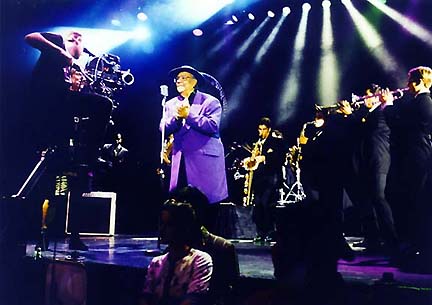
This time when I hit the stage with Papa Lalo, his set list is
much different. And I'm nervous, because I've never played any
of the tunes before, and the entire crowd seems to be mouthing
the lyrics along with Lalo. The parodies of English-language hits
were easy for me. I know those songs like the back of my hand.
But when Lalo launches into "Corrido De Delano" a protest
song from the days of Chavez' leadership of the farmworkers' strike
and "Y Soy Chicano", I'm hanging on for dear life. I
barely know this chapter of the Guerrero songbook, and everybody
here but me seems to have committed it to memory. This set isn't
about rhythm'n'blues or comedy. This is folk music about people
being proud in the face of adversity. For this crowd, the set
mostly sticks to the theme of Chicano pride, with an occasional
parody thrown in. He speaks entirely in Spanish between songs.
The crowd loves him, and dearly.
Although regarded mainly as a parodist, Guerrero has made all
kinds of Latin music mariachi, boleros, banda, Cugat-esque tropical,
salsa and corridos. He's also cut credible records in many Anglo
pop styles (in English), and even a great deal of Spanish-language
children's music. In 1994, he joined Los Lobos for a children's
record, Music for Little People (which earned him his first Grammy
nomination). When asked if he ever worried about confusing his
audience, Guerrero shakes his head emphatically:
"No! Because I'm that kind of a guy I just want to write
something if I get inspired. Whether it's in English or Spanish,
a parody, a love song, swing . . . I don't mind."
While Lalo was busy in the sixties running and performing at his
club, Lalo's, the California farm workers went on their
famous strike. His Chavez-era protest songs are treasures, their
reportage of life in the San Joaquin Valley on a par with Merle
Haggard's best, their message of pride akin to Curtis Mayfield's.
"Corrido De Delano" is like a Chicano "Keep On
Pushing".
The alliance between Guerrero and Cesar Chavez began in an offhanded
way.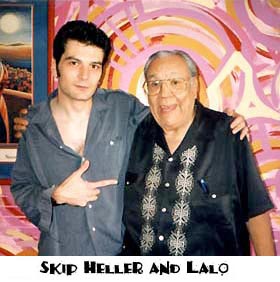
"When I first met him, in Delano, I was on the road with
my band. We'd go up north to Bakersfield, Fresno, Tulare, Merced,
Sacramento, San Jose. Cesar would come [to the clubs] with his
friends, looking for girls. He'd say, `Lalo, they're gonna be
picking onions over in Sacramento Valley' or `Lalo, they're gonna
be picking strawberries in Bakersfield,' and the pickers were
mostly Chicanos, so he'd tip me to where they'd be, we'd go there
to play, and sure enough, there would be a lot of people to see
us.
"He and I stayed close to the end, and of course, I played
some of the marches and met many of the people."
Guerrero played zillions of rallies of and benefits for the farmworkers.
He also used his celebrity to bring people's attention to the
harmful effects pesticides sprayed on the fruit had on the people
who made their living in the fields handling that fruit.
Leaving Los Angeles after he sold Lalo's in 1972, his plan
was to return to his hometown of Tucson, open a little Mexican
restaurant, maybe do a little strolling table-to-table with the
guitar. He got in the car intending to resettle. He didn't make
it. While driving through Palm Springs, he called his friend Gloria
Becker, a local booking agent.
"She said, `Lalo, I need you to play. They're opening
a beautiful Mexican restaurant here.' Well, they made me an offer
I couldn't refuse, and I stayed for 24 years. The pay was excellent,
and it worked out better than Tucson would have, because I don't
know anybody there anymore and I still have so much to do in
Los Angeles. I'm only two hours away, so I get here pretty often."
 Guerrero still lives near Palm Springs, in semiretirement.
When KPCC disc jockey Sancho launched the Chicano Music Awards
a few years back, Lalo was the first recipient. Terrible at sitting
still, he was busy promoting his two new discs and playing wherever
he is asked, and a Lalo Guerrero Big Band concert was in the works
under Esparza's eye, but has not yet been staged. He recently
had made a music video in support of Vamos a Baile, and
a local newsmagazine show recently featured a segment on him.
He was an octogenarian perpetual-motion machine, and nothing about
him looked ready to slow down.
Guerrero still lives near Palm Springs, in semiretirement.
When KPCC disc jockey Sancho launched the Chicano Music Awards
a few years back, Lalo was the first recipient. Terrible at sitting
still, he was busy promoting his two new discs and playing wherever
he is asked, and a Lalo Guerrero Big Band concert was in the works
under Esparza's eye, but has not yet been staged. He recently
had made a music video in support of Vamos a Baile, and
a local newsmagazine show recently featured a segment on him.
He was an octogenarian perpetual-motion machine, and nothing about
him looked ready to slow down.
Although the sun beat down on us hard during
that forty minute set we played, Lalo is still buoyant as he sits
under a shady tree signing autographs, and, true to form, flirts
with every woman who comes within arm's length. He sips a light
beer and chit-chats with the musicians. After a couple of hours
of food, music, and talk, Sherilyn tells us we have to go. Lalo
nods in agreement, and we walk with her to the parking lot.
We stand at the curb with our instrument cases as she fetches
her car, and I tell Lalo he looks a little tired. The sun was
merciless onstage while we played, and even the shade tree wasn't
much protection after the fact. Lalo is tired, but he just shrugs.
"I love to be around musicians, around music. I don't tell
myself, `Keep active' or anything. I just love what I'm doing,
and lately I've been getting recognition, which feels very good.
I wouldn't try to stop something that feels so good."
- © 2000 Skip Heller
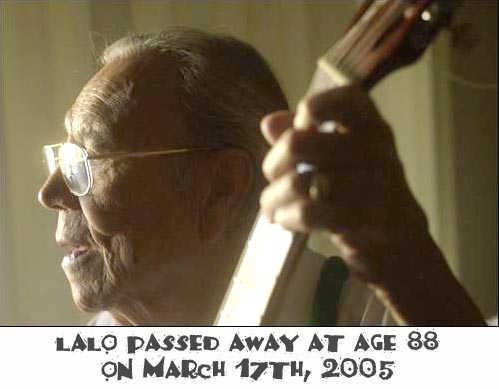
can be ordered directly with a
simple click on the CD cover
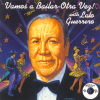
Special thanks to Benjamin Esparza
of Break-Records for use of the photos on this page
For more photos and informative
articles on Mr. Guerrero, please visit
www.break-records.com






 Crockett owed his celebrity to his shooting
Mexicans at the Alamo, the Crockett TV show was quite popular
with Chicanos. Pancho, on the other hand, was a lazy, siesta-addicted
Mexican who opens a taco stand on Olvera Street.
Crockett owed his celebrity to his shooting
Mexicans at the Alamo, the Crockett TV show was quite popular
with Chicanos. Pancho, on the other hand, was a lazy, siesta-addicted
Mexican who opens a taco stand on Olvera Street.

 Guerrero still lives near Palm Springs, in semiretirement.
When KPCC disc jockey Sancho launched the Chicano Music Awards
a few years back, Lalo was the first recipient. Terrible at sitting
still, he was busy promoting his two new discs and playing wherever
he is asked, and a Lalo Guerrero Big Band concert was in the works
under Esparza's eye, but has not yet been staged. He recently
had made a music video in support of Vamos a Baile, and
a local newsmagazine show recently featured a segment on him.
He was an octogenarian perpetual-motion machine, and nothing about
him looked ready to slow down.
Guerrero still lives near Palm Springs, in semiretirement.
When KPCC disc jockey Sancho launched the Chicano Music Awards
a few years back, Lalo was the first recipient. Terrible at sitting
still, he was busy promoting his two new discs and playing wherever
he is asked, and a Lalo Guerrero Big Band concert was in the works
under Esparza's eye, but has not yet been staged. He recently
had made a music video in support of Vamos a Baile, and
a local newsmagazine show recently featured a segment on him.
He was an octogenarian perpetual-motion machine, and nothing about
him looked ready to slow down.
